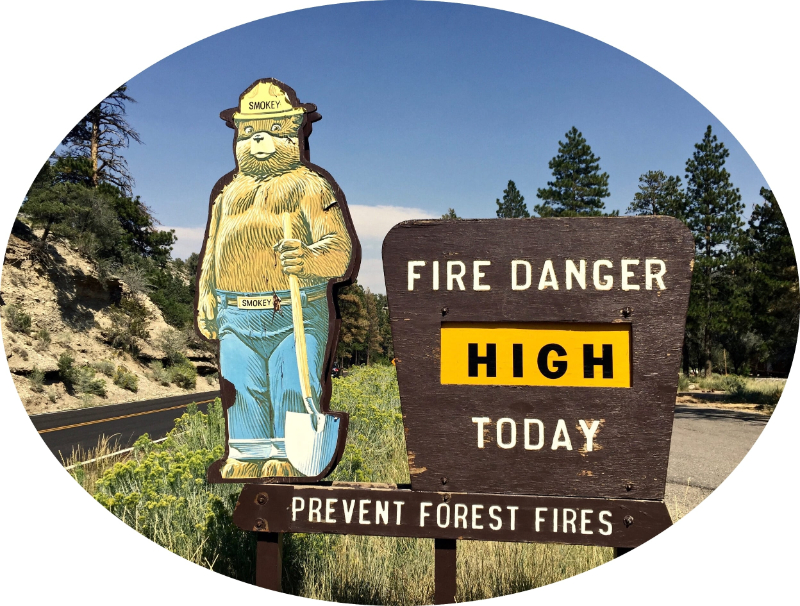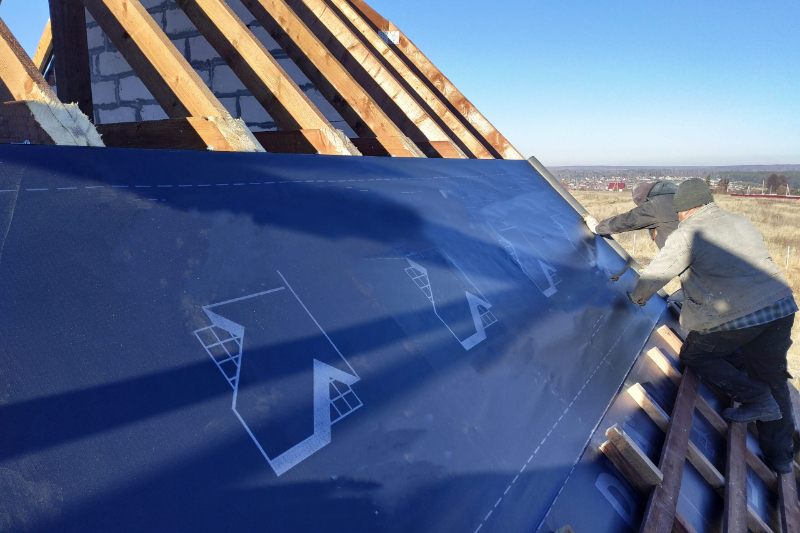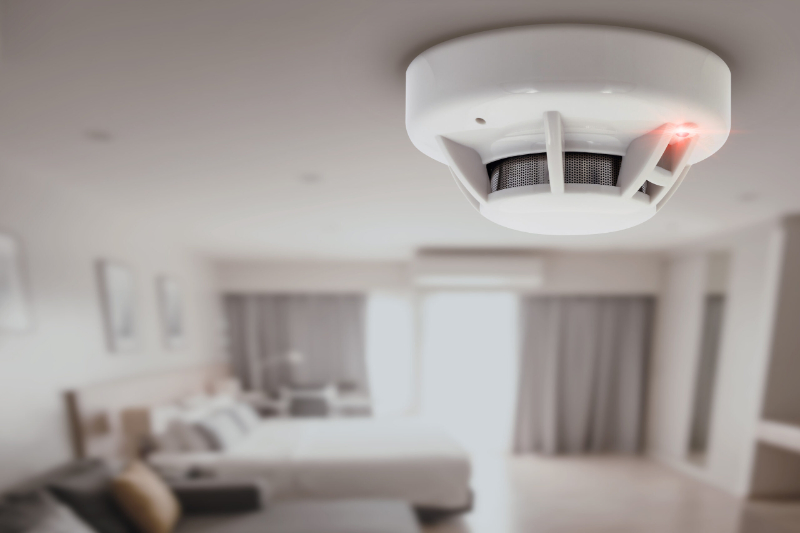
Looking how to protect a home against wildfires?

Are you a Texan Homeowner concerned about the increasing threat of wildfires?
Texas is so hot, even the fires are wearing cowboy hats.
Well, I certainly am. Having lived in Texas since 2004 making sure my home does not burn down has been an ultimate goal.
Hey y’all, it’s your realtor friend Kathy here. We are writing to you today to talk about wildfires!

So… if this is something you want to know more about.. then look no further!
And this ultimate guide will equip you with the knowledge and strategies needed to fireproof your home, and protect it from devastating effects of wildfire. Texas, with its vast landscapes and dry climate is particularly susceptible to natural disasters, such as fire.
But fear not, as we have gathered some expert advice, practical tips and innovative solutions to help you safeguard your property and loved ones. From creating defensible space around your home to selecting fire resistant building materials we will walk you through every step of the process.
Join us as we delve into the world of fire, proofing, empowering you to not only mitigate the potential risks, but also gain peace of mind in the face of this ongoing threat.
Let’s get started on this journey to safeguard your taxes home against wildfires!
Understanding the Risk of Wildfires in Texas
Texas is no stranger to wildfires. In fact, it’s so freaking hot and dry in Texas that the state is basically a giant tinderbox. Just one errant spark could set the whole place ablaze.
Of course, wildfires aren’t always caused by sparks. Sometimes they’re caused by lightning strikes, or even by people who are just plain careless. But no matter how they start, wildfires can be devastating. They can destroy homes, businesses, and even entire communities.
So what can you do to protect yourself from wildfires? Well, for starters, you should familiarize yourself with local fire hazard maps. These maps will show you the areas that are most at risk for wildfires. You should also stay updated on weather conditions. If there’s a high risk of fire, you should take steps to protect your home, such as clearing away any dead vegetation and trimming back your trees.
And of course, you should never throw away cigarettes or other flammable materials in the open. That’s just asking for trouble.
Remember, wildfires are no joke. They can be deadly. So please, take steps to protect yourself and your loved ones.

The Importance of Fireproofing Your Home
When it comes to protecting your home from wildfires, fireproofing is of paramount importance. Fireproofing is like putting on sunscreen for your home. It doesn’t make your home immune to fire, but it can help protect it from serious damage.
Fireproofing involves implementing measures to minimize the risk of ignition and reduce the spread of fires. By investing time and resources into fireproofing your home, you significantly increase its chances of withstanding a wildfire and minimize potential damage.
The benefits of fireproofing your home extend beyond protection against wildfires. Fireproofing measures can also enhance the overall safety and security of your property, providing peace of mind for you and your family. Additionally, fireproofing can potentially lower insurance premiums, as it demonstrates your commitment to reducing the risk of fire-related incidents.
Remember, fireproofing is not a one-time process but an ongoing commitment to maintaining a safe and resilient home. By incorporating fireproofing measures into your regular maintenance routine, you can ensure that your home remains protected year-round.
Assessing the Vulnerability of Your Property
Before you can fireproof your home, you need to know how vulnerable it is to wildfires. This is called a vulnerability assessment. A vulnerability assessment is a lot like a job interview. You want to make sure you’re prepared for the worst.
But, to help make it a little less scary… Let’s think of a vulnerability assessment as like going through security at the airport, you’ve gotten to do it, it isn’t all that fun, and you feel so relieved once you are through, only we are talking about your home.
It helps you identify the things that could make your home more likely to catch fire, and it helps you come up with a plan to reduce the risk.
Here are some things you’ll need to do for a vulnerability assessment:
- Look at your surroundings. How close is your home to forests, grasslands, or shrublands? These are all areas where wildfires are more likely to start.
- Check your construction materials. Are your siding and roof made of wood? If so, they’re more likely to catch fire than other materials.
- Inspect your property for flammable materials. Are there any dry leaves, debris, or firewood lying around? These things could ignite and start a fire.
Once you’ve completed your vulnerability assessment, you’ll have a better idea of what needs to be done to fireproof your home.

Fire-Resistant Materials and Construction Techniques
When it comes to fireproofing your home, selecting the right materials and construction techniques can make a significant difference in protecting your property from wildfires especially during the construction phase.
Start by considering fire-resistant materials for your home’s exterior. Options such as stucco, brick, or cementitious siding can provide an added layer of protection against heat and flames. These materials are designed to resist ignition and slow down the spread of fires.
In addition to choosing fire-resistant materials, consider incorporating fire-resistant construction techniques. For example, installing a fire-resistant underlayment beneath your roof can help prevent flames from penetrating your home. Similarly, sealing gaps and cracks in your home’s exterior can minimize the risk of ember intrusion during a wildfire.
It is also crucial to pay attention to the windows and doors of your home. Opt for fire-resistant double-paned windows and solid-core doors to reduce the risk of heat transfer and flame penetration.
By combining fire-resistant materials with appropriate construction techniques, you can significantly enhance the fire resistance of your home and increase its chances of withstanding a wildfire.
Creating Defensible Space Around Your Home
Defensible space is like a moat around your home. It doesn’t make your home immune to fire, but it can help protect it from serious damage.
There are a few things you can do to create defensible space around your home:
- Clear away flammable debris. This includes things like dead leaves, branches, and pine needles. You don’t want to give a fire any easy fuel to burn.
- Trim back trees and shrubs. This will help prevent them from catching fire and spreading the flames to your home.
- Plant fire-resistant plants. There are many plants that are naturally resistant to fire. These plants can help create a natural barrier around your home.
- Maintain proper clearance between structures. Ideally, there should be a minimum distance of 30 feet between your home and any outbuildings or other structures. This gap will help prevent fire from easily transferring between structures and reaching your home.
Creating defensible space around your home is an investment in your safety and peace of mind. It’s also a good way to lower your insurance premiums.
Installing Fire-Resistant Doors and Windows
Windows and doors are vulnerable points in your home’s defense against wildfires. Embers and radiant heat can penetrate these openings and ignite the interior, leading to the rapid spread of fires. Installing fire-resistant doors and windows can significantly reduce this risk and enhance the fire resistance of your home.
When selecting fire-resistant doors, look for products that have been tested and certified to meet fire safety standards. These doors are designed to withstand extreme heat and flames, providing a barrier against fire intrusion.
Similarly, fire-resistant windows are essential for preventing heat transfer and ember intrusion. Look for windows that have been tested and rated for their fire resistance. These windows are typically made with multiple layers of glass and include heat-resistant seals to provide an additional layer of protection.
Remember to ensure proper installation of fire-resistant doors and windows. Improper installation can compromise their effectiveness and increase the risk of fire-related incidents.
By investing in fire-resistant doors and windows, you fortify your home’s defense against wildfires and increase its ability to withstand extreme heat and flames.
Fireproofing Your Roof and Gutters
The roof is one of the most vulnerable areas of your home when it comes to wildfires. Embers can easily land on the roof and ignite flammable materials, leading to the rapid spread of fires. Fireproofing your roof is therefore essential for protecting your home from the devastating effects of wildfires.
Here are some tips for fireproofing your roof and gutters:
- Choose fire-resistant materials. Avoid wood shake or shingles, as they are highly susceptible to ignition. Instead, choose metal, tile, or asphalt shingles treated with fire-retardant chemicals.
- Inspect your roof regularly. Look for any damage or loose materials that could become fuel for a fire. Replace any damaged or missing shingles and ensure that all roof vents are covered with mesh screens to prevent ember intrusion.
- Keep your gutters clean. Dry leaves and other combustible materials that accumulate in the gutters can easily ignite during a wildfire. Regularly clean your gutters to remove these flammable materials and reduce the risk of fire ignition.
By fireproofing your roof and gutters, you significantly reduce the risk of fire spreading to your home and increase its chances of withstanding a wildfire.

Maintaining a Fire-Safe Landscape
Maintaining a fire-safe landscape is an integral part of fireproofing your home. A well-maintained landscape not only enhances the aesthetic appeal of your property but also acts as a buffer against wildfires.
Start by keeping your lawn well-watered and regularly mowed. Well-hydrated and properly maintained grass is less likely to ignite during a wildfire. Additionally, consider replacing highly flammable grass species with more fire-resistant alternatives.
When it comes to trees, keep them pruned and remove any dead or dry branches. Deadwood acts as fuel for fires and can easily ignite during a wildfire. Additionally, ensure that there is proper spacing between trees to prevent the easy spread of flames.
Consider incorporating fire-resistant plants and shrubs into your landscape design. These plants are less likely to ignite and can act as a natural barrier against the spread of fires. Consult with local nurseries or fire-resistant plant lists to identify suitable options for your area.
By maintaining a fire-safe landscape, you create a protective barrier around your home and reduce the risk of fire-related incidents during a wildfire.
Fireproofing Your Interior with Fire-Resistant Furnishings and Materials
While fireproofing the exterior of your home is crucial, it is equally important to consider the interior. Fire-resistant furnishings and materials can significantly reduce the risk of fire ignition and enhance the safety of your home.
- Fire-resistant upholstery and fabrics. Look for products that have been treated with fire-retardant chemicals or are inherently fire-resistant. Or, you could go for the more natural route and get some fire-retardant sheepskin rugs.
- Fire-resistant curtains, blinds, and rugs. These will help keep the fire contained, so you can focus on making a run for it.
- Fire-resistant flooring. Concrete, tile, or stone are all good options. Just make sure they’re not made of lava.
- Smoke detectors and fire extinguishers. Test them regularly and make sure they’re in working order. You don’t want to be fumbling around in the dark for your fire extinguisher when the fire alarm goes off.
- Fire sprinkler system. This is an added layer of protection that could save your life.
- Fire safety education. Make sure you and your family know what to do in the event of a fire. Have an evacuation plan and practice it regularly.
Educate yourself and your family on fire safety practices, such as creating and practicing an evacuation plan. Knowing what to do in the event of a fire can significantly increase your chances of survival and minimize the risk of injuries.
By incorporating fire-resistant furnishings and materials into your interior and practicing fire safety measures, you create a safer living environment for you and your loved ones.
Developing an Evacuation Plan
In the event of a wildfire, having a well-thought-out evacuation plan is crucial. A clear and practiced plan can help ensure the safety of you and your loved ones and minimize the risk of harm during a wildfire.
Start by identifying multiple evacuation routes from your home. Consider both primary and secondary routes, and ensure that everyone in your household is familiar with them. Practice driving these routes to familiarize yourself with the roads and any potential obstacles.
Establish a designated meeting place outside your neighborhood where you can reconnect with family members in case you get separated during the evacuation. Choose a location that is easily accessible and well-known to all family members.
Prepare an emergency kit that includes essential items such as food, water, medication, important documents, and clothing. Keep this kit in an easily accessible location and ensure that everyone in your household knows where it is located.
Stay informed about current fire conditions and emergency notifications. Sign up for local alerts and have a battery-powered radio on hand to receive updates in case of power outages.
Practice your evacuation plan regularly with your family. Conduct drills to ensure that everyone knows their roles and responsibilities during an evacuation. This practice helps build muscle memory and ensures a smooth and efficient evacuation when it matters most.
By developing and practicing an evacuation plan, you increase your chances of safely navigating a wildfire and protect the well-being of your loved ones.
Additional Precautions for High-Risk Areas
- Install a residential sprinkler system. This is like having a personal fireman on call 24/7. These systems are designed to activate when they detect heat or flames, providing an additional layer of protection against fires. Residential sprinkler systems can significantly reduce the risk of fire-related incidents and increase the chances of saving your home during a wildfire.
- Invest in an emergency generator. This will keep your lights on and your fridge running even if the power goes out. Power outages can hinder evacuation efforts and limit access to critical information. An emergency generator can provide essential power for communication devices, medical equipment, a
- Consult with local fire departments or fire safety professionals. They know what’s up. They might have additional recommendations specific to your high-risk area. These experts have valuable insights and knowledge about fireproofing measures that are effective in your local context.
Fireproofing Your Home on a Budget
Fireproofing your home doesn’t have to break the bank. There are cost-effective measures and strategies that you can implement to enhance the fire resistance of your property without compromising your budget.
Here are a few tips:
- Prioritize your fireproofing efforts. Not all fireproofing measures are created equal. Some are more important than others. Start by identifying the most critical areas that require immediate attention, such as clearing vegetation around your home or installing fire-resistant doors.
- Consider DIY fireproofing projects. There are many fireproofing projects that you can do yourself. This can save you a lot of money. For example, you can clear debris from your gutters or seal gaps and cracks in your home’s exterior with basic tools and materials available at most hardware stores.
- Explore government grants or assistance programs. Some local or state agencies offer financial incentives or resources to encourage homeowners to undertake fireproofing measures. Research these programs and take advantage of any opportunities that may be available to you.
- Compare prices and quality. When shopping for fireproofing materials or services, compare prices and quality from different suppliers. Look for discounts or seasonal sales. You may also be able to find used fireproofing materials that are still in good condition.
By following these tips, you can fireproof your home on a budget without sacrificing quality.
Conclusion
Fireproofing your home is an important investment in your safety and peace of mind. But don’t worry, you don’t have to turn your house into a literal fireproof bunker. Just follow these tips, and you’ll be well on your way to a fire-safe home.

Here are some key takeaways from this guide:
- Wildfires are a major threat to homeowners in Texas.
- There are steps you can take to fireproof your home and protect it from wildfires.
- The best fireproofing measures include selecting fire-resistant materials, creating defensible space around your home, and installing fire-resistant doors and windows.
- You can also maintain a fire-safe landscape by clearing vegetation and combustible materials, planting fire-resistant plants, and keeping trees pruned.
- If a wildfire threatens your home, it is important to have a plan in place. This includes having a safe place to evacuate to, knowing your evacuation routes, and packing an emergency kit.
To reiterate it all again… here are some additional tips for fireproofing your home:
- Keep your gutters clean and debris-free.
- Install smoke detectors and carbon monoxide detectors throughout your home.
- Have a fire escape plan in place and practice it regularly.
- Know your evacuation routes and have a safe place to go in case of a wildfire.
- Stay informed about the fire danger in your area and be prepared to evacuate if necessary.
And most importantly, don’t forget to have a sense of humor. After all, fireproofing your home is important, but it shouldn’t be a total drag. So if you see a funny fire safety meme, go ahead and share it. Just don’t share it while you’re standing next to a lit match.
P.S. If you’re really serious about fireproofing your home, you can always hire a professional. But if you’re on a budget, you can do most of this yourself. Just remember to be safe and have fun!
I hope this helps!
Meet Kathy

… a cat lover and local aficionado, she goes out of her way to discover the best that Austin, Texas has to offer: from local businesses and schools, to local events and entertainment.
Kathy knows Austin.
Kathy knows community.
Kathy knows home.
You want to know what Austin has to offer, and when homes are hitting the market, you want to be the first to know.
Having lived in Austin since 2004, Kathy is your key to unlocking the city.
Interested in moving to the area? Book a chat with Kathy!

